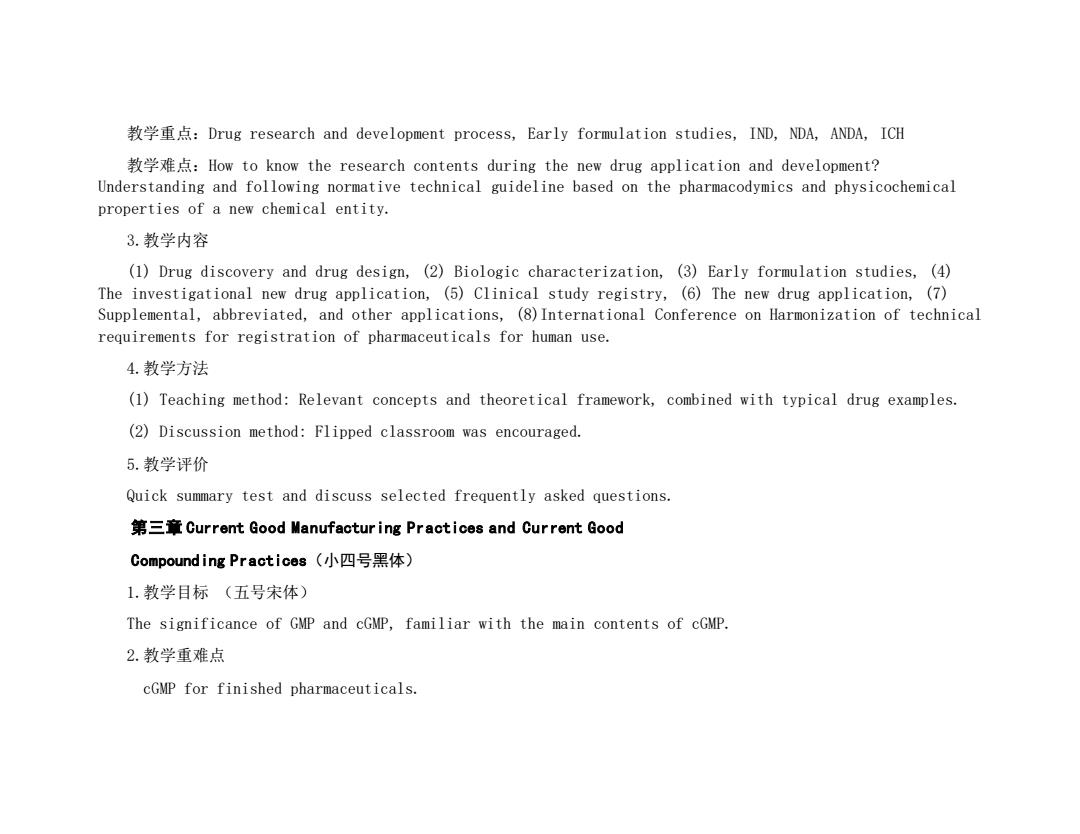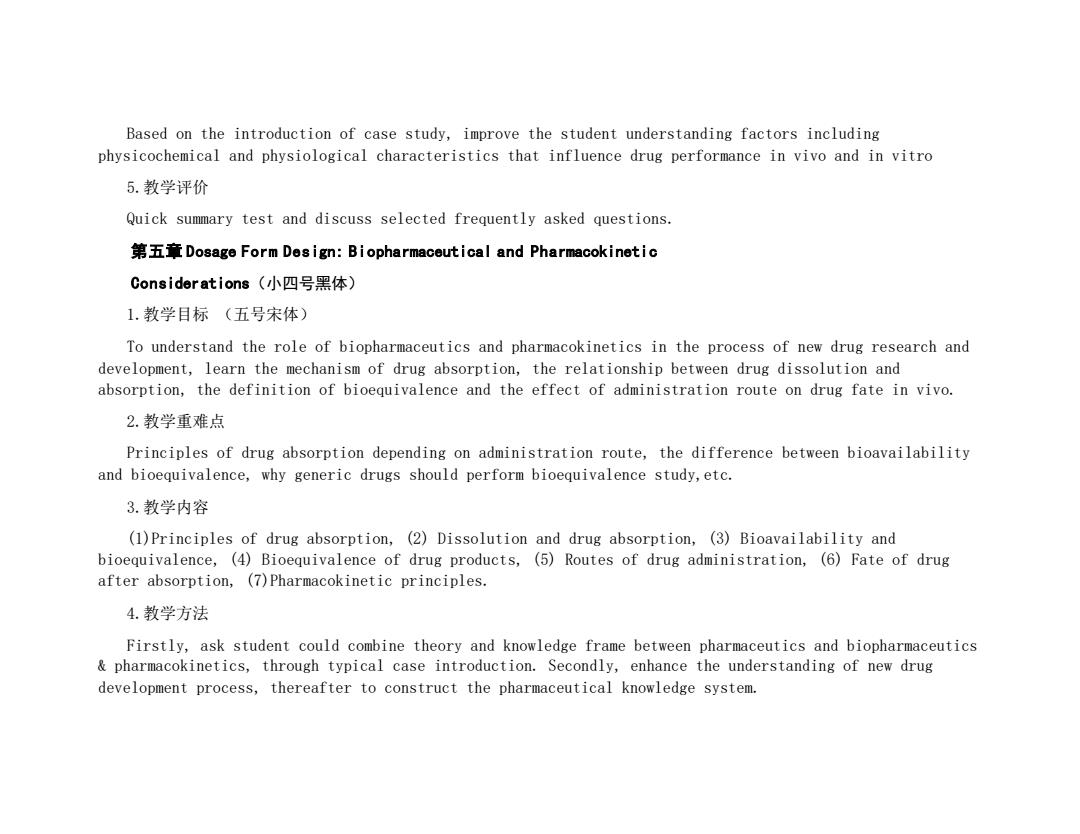
教学重点:Drug research and development process,Early formulation studies,IND,NDA,ANDA,ICH 教学难点:How to know the research contents during the new drug application and development? Understanding and following normative technical guideline based on the pharmacodymics and physicochemical properties of a new chemical entity. 3.教学内容 (1)Drug discovery and drug design,(2)Biologic characterization,(3)Early formulation studies,(4) The investigational new drug application,(5)Clinical study registry,(6)The new drug application,(7) Supplemental,abbreviated,and other applications,(8)International Conference on Harmonization of technical requirements for registration of pharmaceuticals for human use. 4.教学方法 (1)Teaching method:Relevant concepts and theoretical framework,combined with typical drug examples. (2)Discussion method:Flipped classroom was encouraged. 5.教学评价 Quick summary test and discuss selected frequently asked questions. 第三章Current Good Manufactur ing Practices and Current Good Compound ing Practices(小四号黑体) 1.教学目标(五号宋体) The significance of GMP and cGMP,familiar with the main contents of cGMP. 2.教学重难点 cGMP for finished pharmaceuticals
教学重点:Drug research and development process, Early formulation studies, IND, NDA, ANDA, ICH 教学难点:How to know the research contents during the new drug application and development? Understanding and following normative technical guideline based on the pharmacodymics and physicochemical properties of a new chemical entity. 3.教学内容 (1) Drug discovery and drug design, (2) Biologic characterization, (3) Early formulation studies, (4) The investigational new drug application, (5) Clinical study registry, (6) The new drug application, (7) Supplemental, abbreviated, and other applications, (8)International Conference on Harmonization of technical requirements for registration of pharmaceuticals for human use. 4.教学方法 (1) Teaching method: Relevant concepts and theoretical framework, combined with typical drug examples. (2) Discussion method: Flipped classroom was encouraged. 5.教学评价 Quick summary test and discuss selected frequently asked questions. 第三章 Current Good Manufacturing Practices and Current Good Compounding Practices(小四号黑体) 1.教学目标 (五号宋体) The significance of GMP and cGMP, familiar with the main contents of cGMP. 2.教学重难点 cGMP for finished pharmaceuticals

3.教学内容 (1)Standards for current good manufacturing practice,(2)cGMP for finished pharmaceuticals,(3) Additional cGMP regulatory requirements. 4.教学方法 Combined with the content of cGMP in abroad,systematically introduce the composition of cGMP by reference and PPT. 5.教学评价 Quick summary test and discuss selected frequently asked questions. 第四章Dosage Form Des ign:Pharmaceutical and Formulation Considerations(小四号黑体) 1.教学目标(五号宋体) Ask student understand the necessity of dosage form in clinical therapy,get familiar with the factors that need to be considered in the design of dosage form,and understand the often used pharmaceutical excipients. 2.教学重难点 The difference between drug and drug product,the necessity of drug preparation,various factors that need to be considered when designing dosage forms. 3.教学内容 (1)The need for dosage forms,(2)General considerations in dosage form design,(3)Pharmaceutical ingredients and excipients. 4.教学方法
3.教学内容 (1)Standards for current good manufacturing practice,(2) cGMP for finished pharmaceuticals,(3) Additional cGMP regulatory requirements. 4.教学方法 Combined with the content of cGMP in abroad, systematically introduce the composition of cGMP by reference and PPT. 5.教学评价 Quick summary test and discuss selected frequently asked questions. 第四章 Dosage Form Design: Pharmaceutical and Formulation Considerations(小四号黑体) 1.教学目标 (五号宋体) Ask student understand the necessity of dosage form in clinical therapy, get familiar with the factors that need to be considered in the design of dosage form, and understand the often used pharmaceutical excipients. 2.教学重难点 The difference between drug and drug product, the necessity of drug preparation, various factors that need to be considered when designing dosage forms. 3.教学内容 (1) The need for dosage forms, (2) General considerations in dosage form design, (3) Pharmaceutical ingredients and excipients. 4.教学方法

Based on the introduction of case study,improve the student understanding factors including physicochemical and physiological characteristics that influence drug performance in vivo and in vitro 5.教学评价 Quick summary test and discuss selected frequently asked questions. 第五章Dosage Form Design:Biopharmaceutical and Pharmacokinetic Considerations(小四号黑体) 1.教学目标(五号宋体) To understand the role of biopharmaceutics and pharmacokinetics in the process of new drug research and development,learn the mechanism of drug absorption,the relationship between drug dissolution and absorption,the definition of bioequivalence and the effect of administration route on drug fate in vivo. 2.教学重难点 Principles of drug absorption depending on administration route,the difference between bioavailability and bioequivalence,why generic drugs should perform bioequivalence study,etc. 3.教学内容 (1)Principles of drug absorption,(2)Dissolution and drug absorption,(3)Bioavailability and bioequivalence,(4)Bioequivalence of drug products,(5)Routes of drug administration,(6)Fate of drug after absorption,(7)Pharmacokinetic principles. 4.教学方法 Firstly,ask student could combine theory and knowledge frame between pharmaceutics and biopharmaceutics pharmacokinetics,through typical case introduction.Secondly,enhance the understanding of new drug development process,thereafter to construct the pharmaceutical knowledge system
Based on the introduction of case study, improve the student understanding factors including physicochemical and physiological characteristics that influence drug performance in vivo and in vitro 5.教学评价 Quick summary test and discuss selected frequently asked questions. 第五章 Dosage Form Design: Biopharmaceutical and Pharmacokinetic Considerations(小四号黑体) 1.教学目标 (五号宋体) To understand the role of biopharmaceutics and pharmacokinetics in the process of new drug research and development, learn the mechanism of drug absorption, the relationship between drug dissolution and absorption, the definition of bioequivalence and the effect of administration route on drug fate in vivo. 2.教学重难点 Principles of drug absorption depending on administration route, the difference between bioavailability and bioequivalence, why generic drugs should perform bioequivalence study,etc. 3.教学内容 (1)Principles of drug absorption, (2) Dissolution and drug absorption, (3) Bioavailability and bioequivalence, (4) Bioequivalence of drug products, (5) Routes of drug administration, (6) Fate of drug after absorption, (7)Pharmacokinetic principles. 4.教学方法 Firstly, ask student could combine theory and knowledge frame between pharmaceutics and biopharmaceutics & pharmacokinetics, through typical case introduction. Secondly, enhance the understanding of new drug development process, thereafter to construct the pharmaceutical knowledge system